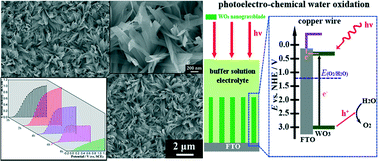Tailored preparation of WO3 nano-grassblades on FTO substrate for photoelectrochemical water splitting†
Abstract
WO3 nano-grassblades (NGs) were successfully synthesized on a fluorine-doped tin dioxide (FTO) substrate by a two-step hydrothermal method, which involves a nanoseed-generating step and a nano-grassblade-growth step using urea as the morphology-controlling agent. The influence of the seeding procedure on the morphology of the obtained WO3 nanostructure was systematically investigated. The synthesized WO3 NGs were revealed to have a single crystalline structure with a large aspect ratio and perpendicular alignment on FTO substrates. The photoelectrochemical (PEC) water splitting properties of the annealed WO3 NGs were performed in 0.1 M KH2PO4/K2HPO4 buffer solution (pH 7), exhibiting an onset potential of ca. −0.1 V vs. SCE and a maximum photocurrent density of 1.2 mA cm−2 under 1.5 G illumination. Growth time-dependent PEC activity and specific surface area data confirm that the efficient PEC activity of WO3 NGs is attributed to their high specific surface area, which is beneficial in enlarging the WO3/solution interface for water oxidation. This two-step hydrothermal growth technique demonstrates a unique advantage in ensuring firm adhesion of the WO3 film to the FTO substrate and offers a novel route for improving the performance of PEC water splitting devices.


 Please wait while we load your content...
Please wait while we load your content...